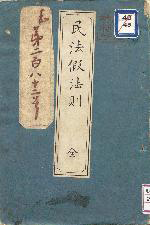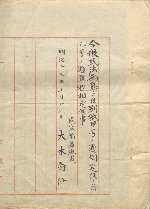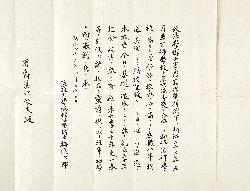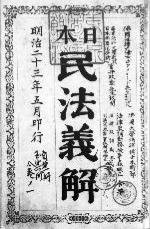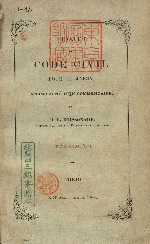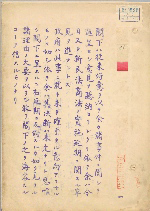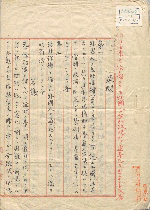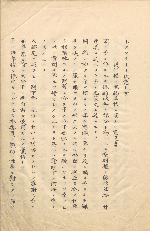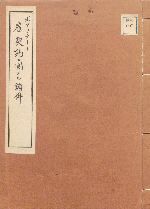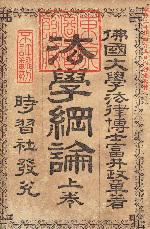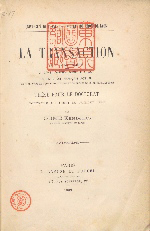![]()
Chapter 1: Politics and law
Section 3: Establishment of the Civil Code
The Meiji government sought the revision of the unequal treaties (abolition of extraterritoriality, restoring tariff autonomy), however the lack of a modern legal system was seen as a problem by many countries, leading to the establishment of a law code becoming a pressing matter. The government decided to refer to French law, which had been used as a model for legal systems in various countries in Europe. First, the government had MITSUKURI Rinsho translate French laws. He attempted to single-handedly create a compilation of the Civil Code, however it was not enough so Georges Hilaire Bousquet (1846-1937) and Gustave Émile Boissonade (1825-1910) were successively invited from France to work on drafting the Civil Code. In the Old Civil Code, which was drafted mainly with Boissonade, the influence of the French Civil Code (Code Napoléon) was strong, however as a result of the Civil Code controversy, it was never enacted. The New Civil Code which was enacted afterward is often pointed out as being influenced by the first draft of the Civil Code of the German Empire, however 2 of the 3 authors studied law in France.
Compilation of the Old Civil Code
Minpō karihōsoku zen [Library of the Supreme Court, Branche of the NDL] 
ETO Shimpei took the initiative in compiling the legal code for the Meiji government. Eto served as the Minister of Justice in 1972, established a Civil Code Council in the Ministry of Justice and work on compiling the Civil Code. These materials are the outcome of the council, and are one of the various drafts created at the time. Georges Hilaire Bousquet, who worked on the writing, was a Paris born attorney who graduated from University of Paris. He came to Japan in 1872 as a hired foreigner advisor for the Ministry of Justice. He taught law at Myoboryo, however he returned to France after Boissonade came to Japan in 1876. This tentative regulation is thought to have been intended to actually be implemented, however the draft was limited to only the portion on identity cards. This mimicked the French Civil Code (Code Napoléon) as did Boissonade's Civil Code, and was composed of 6 introductory articles in addition to the 88 original articles for a total of 94 articles.
Minpō hensan no ken ukagaisho oyobi ketsugi [Papers of MITSUKURI Gempo and MITSUKURI Rinsho (Deposit), #110] 
After the Civil Code compilation project by ETO was aborted with the formation of the Provisional Civil Code, compilation of the civil code was continued by MITSUKURI Rinsho and MUTAGUCHI Michiteru (birth and death dates unknown) under OKI Takato (1832-1899), who took over as Minister of Justice, and a draft was finished in 1878. However, this was an attempt at literally translating and transplanting French Civil Code, and it proved difficult to implement as it was, so it again resulted in a Civil Code compilation project being carried out. In February of 1880, OKI became the chairperson of the Genroin and in April of the same year, he was appointed the president of the Civil Code compilation, and compilation of the Civil Code began focusing on Boissonade.
This material was the beginning of this compilation, and consist of documents in which OKI asks Grand Minister of State SANJO Sanetomi (1837-1891) about the scope of his authority, which transcribe the rules of the Drafting Bureau of the Civil Code, and which were left in the possession of MITSUKURI. The First Division of the Bureau to which both Boissonade and MITSUKURI belonged to, was appointed with drawing up the draft laws in French and translating them to Japanese.
Hōsei daigaku karano kanshajō (Dōdaigaku sōri UME Kenjirō mei) [Papers of MITSUKURI Gempo and MITSUKURI Rinsho (Deposit), #219] 
MITSUKURI Rinsho was born as the grandchild of Dutch scholar MITSUKURI Gempo (1798-1863) in 1846 in Edo residence of the Tsuyama Domain. He studied Chinese studies, Dutch studies and English studies, and in 1861, he became an Associate Professor of English Studies at Banshoshirabe-sho. Later he studied French studies, and travelled to France as an attendant to TOKUGAWA Akitake (1853-1910) on the occasion of the 1867 Paris exposition. After returning to Japan, he opened a private school and taught students including OI Kentaro and NAKAE Chomin. In addition to working on translation of French legal documents, he also worked as a member of the House of Peers.
This material is a letter of thanks sent on April 25, 1909 from Hosei University President UME Kenjiro (1860-1910) to Rinsho's son Toshio (?-1923), which celebrate Rinsho who was the Principal of Wafutsu Law School (the predecessor to Hosei University) when it was founded. UME served as Assistant Principal under Rinsho.
Gustave Émile Boissonade and TOMII Masaakira (Review), Nihon minpō gige, 1890 [26-337ロ] 
Gustave Émile Boissonade was a French law scholar. He was born in the Paris suburb of Vincenne and graduated from the University of Paris. In 1873, he came to Japan after being invited by the government, and taught French law at Myoboryo and other locations. He also drafted the Criminal Procedure Code and Old Penal Code, and worked to abolish the use of torture. In 1879, he began drawing up a draft of the Civil Code, completing it after 10 years of work. Boissonade drew up only the portion dealing with property laws, however, it also had influence on the portion concerning family laws, which was drawn up by Japanese committee members. This draft was published in 1890, however a number of criticisms sprung up in the year before, resulting from conflicts between universities and other causes, leading to confrontation (the Civil Code controversy) between those who felt the draft should be implemented as planned (the danko-ha, or enforcement faction) and those who felt the implementation should be delayed (the enki-ha, or delay faction). This text is an annotation of Boissonade's Old Civil Code.
G. Boissonade, Projet de Code civil pour le Japon, accompagné d'un commentaire, 1880 [J-45] 
Napoléon Bonaparte (1769-1821) himself participated in the compilation of the Code Napoléon, which was enacted in 1804 and served as a model for the Civil Code in many countries. The code was composed of Section 1 Men, Section 2 Goods and Various Changes of Ownership and Section 3 Acquisition of Property. This structure divided into people, things and actions is known as the Institutiones System. The Old Civil Code by Boissonade also used the same system; however it used 5 sections making it slightly different. It is said that was also the influence of Italian Civil Code. This text is the French draft (volume 2 only) by Boissonade.
The New Civil Code is modelled on the first draft of the Civil Code of German Empire, using its system for the entire code, called the Pandekten System, which places general provisions before the separate individual provisions, however it has been pointed out that French law had a major influence through the content of Old Civil Code.
Minpō shōhō no jisshi enki ni kansuru iken [Papers of OKI Takato (Papers), #52-7] 
This is a written opinion from Boissonade to Minister of Foreign Affairs ENOMOTO Takeaki (1836-1908) written on April 30, 1892 as the conflict revolving around the enactment of the Civil Code between the delay faction of HOZUMI Yatsuka (1860-1912), etc., and the enforcement faction of UME Kenjiro, etc., intensified. This material is a hectograph reproduction, which were left in the possession of OKI Takato, Minister of Education at the time. The opinion presents three reasons arguing against the delay of enactment, one of which was that a Civil Code and Commercial Code were necessary for revision of the unequal treaties, which is why the appeal is made not to the Minister of Justice, but to the Minister of Foreign Affairs. However, in May of the following year, a bill for the delay of enactment was submitted to the Diet and both houses resolved to delay the enactment. As a result, the Old Civil Code ended up not being enacted and new work began on recompiling the Civil Code.
Boissonade Tōgi [Papers of OKI Takato (Papers), #2‐12] 
This material is a report from legal advisor Boissonade. In response to a legal inquiry regarding extraterritoriality, Boissonade explains, "First, please examine the main body of the treaties, and then ask if there are any specific articles regarding which you have questions.", and then responds while providing detailed examples on the general handling when something is not explicitly prescribed by the treaties. The materials are written in India ink on Ministry of Justice ruled paper, and are thought to be from when OKI Takato, who formerly held the materials, served as Minister of Justice. OKI was originally from the Saga Domain, and as Minister of Education contributed to the establishment of the education system, and also served in a variety of roles including Prefectural Governor of Tokyo, Minister of Justice and head of the Genroin.
Boissonade shi ikensho [Papers of MITSUKURI Gempo and MITSUKURI Rinsho (Deposit), #125] 
As the establishment of the legal system and the Cabinet system, and the Europeanism policy progressed, aimed at the revision of the unequal treaties, an International Conference on Revision of the Unequal Treaties was held multiple times with representatives from various countries under the leadership of INOUE Kaoru (1835-1915), who served as Minister of Foreign Affairs from 1885. This material is an opposing opinion submitted by Boissonade, who was anxious about the treaties being concluded as they were, because the treaty proposals deliberated on in the conference required many concessions from the Japanese side.
There was also opposition to the revision proposals from the Cabinet, Minister of Justice YAMADA Akiyoshi (1844-1892) and Minister of Agriculture and Commerce TANI Tateki (1837-1911), and the negotiations for revision of the unequal treaties were discontinued. These details spread to the general populace, and as the anti-government trends of the people's rights movement, such as the petition of three major matters, intensified, several pamphlets such as the Seitetsu Yume Monogatari [特70-26] which include not only those opposition but also Itagaki Taisuke's Address, Katsu Awa's Discourse, were distributed aimed at attacking the government. The government cracked down on these movements, and from the end of 1887 until the next year, approximately 50 individuals were arrested, including HOSHI Toru (1850-1901) (the Clandestine Literature Incident).
Boissonade koyō keiyakusho (Copy) [Papers of ITO Miyoji, #315] 
Boissonade was originally employed by the Ministry of Justice, however when his ability became widely known, he also came to work as an advisor for the Legislation Bureau of Seiin, the top policymaking body, the Ministry of Foreign Affairs, the Genroin, Ministry of the Army and other government offices, soon becoming a contest between the different government offices. His employment contract, which was renewed every 3 years from 1873 onward, expired in November of 1888, however because the Civil Code was not yet completed, based on requests from the Ministry of Justice, his contract was renewed for a further 5 years from December 1889. Incidentally, his annual salary was 14,000 yen (the monthly salary for a police officer in 1891 was 8 yen).
In 1895, Boissonade became discouraged with the setback of the Civil Code he had himself worked on and returned to France, and passed away in Antibes in southern France in 1910.
Working towards the compilation of the New Civil Code
TOMII Masaakira, Hōgaku kōron, Jishūsha, 1887 [22-74] 
After the enactment of the Old Civil Code was postponed in 1892, a Codes Investigating Committee was established in the Cabinet the following year, and work compiling the New Civil Code began. In 1895, the final draft was completed, and then in the following year of 1896, Section 1 General Provisions, Section 2 Real Rights, and Section 3 Claims were established, then in 1898 Section 4 Relatives and Section 5 Inheritance were established. HOZUMI Nobushige (1856-1926), TOMII Masaakira (1858-1935) and UME Kenjiro were the draft committee for the New Civil Code.
TOMII was born in Kyoto. He is said to have had difficulty in his pursuit of knowledge due to poverty. He studied at the University of Lyon at his own expense, and in 1883, earned his doctorate with a thesis related to the dissolution of contracts. After returning to Japan, he worked as a professor in the University of Tokyo faculty of law, and was a member of the delay faction during the Civil Code controversy. It is said that TOMII himself was more inclined towards German law. This text is a work from before the controversy, and provides a summary of the distinction between laws and morality, and of constitutional and criminal law.
Kenziro Ume, De la transaction, L.Larose et Forcel, 1889 [96-37(洋)] 
UME Kenjiro was one of the drafters of the New Civil Code. He was born in Izumo (Shimane Prefecture). After studying French at the Tōkyo School of Foreign Languages, he progressed on to the Ministry of Justice Law School. In 1885, it was officially announced that he would study in Germany, however at his request his destination was changed to France, and he studied at the University of Lyon for 3 years. This text is his Thesis on the Transaction, which was his doctoral dissertation submitted to the University of Lyon. This work is said to still serve as an annotation of French Civil Code today. Ume also studied at Friedrich-Wilhelms University of Berlin thereafter. During the Civil Code controversy he was a member of the enforcement faction, however his wish for swift enactment of a Civil Code was respected, and he was appointed to the draft committee for the New Civil Code. Among the three draft committee members, he was the most French law leaning member, and he pointed out as the major influence of French Civil Code in the New Civil Code.

